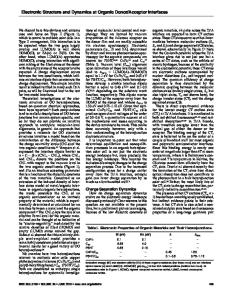Electronic Structure of Silicide-Silicon Interfaces
- PDF / 523,055 Bytes
- 10 Pages / 420.48 x 639 pts Page_size
- 28 Downloads / 337 Views
O.BISI Dept. of Physics, University of Modena, 41100 Modena, Italy ABSTRACT Significant understanding of the processes occurring at the interface between transition metal ultrathin overlayers and silicon has been achieved in recent years. In general these interfaces are highly reactive and the formation of an interfacial silicide compound takes place. The reaction at the near-noble metal-silicon interface can occur even at liquid nitrogen temperature. Furthermore the reaction products can give rise to epitaxial interfaces. How can the covalent bonds in silicon be broken at such a low temperature and eventually give rise to an epitaxial interface are intriguing questions, which cannot be answered without a full understanding of the electronic and atomic processes involved in the interface reaction. Theoretical investigation-through band structure calculations allows us to understand the modifications of the silicide electronic states in the interface region. Assuming various interface geometries (e.g. epitaxial growth or interstitial interdiffusion) the effect of different atomic processes on the electronic properties is analysed and available photoemission and Auger spectroscopic experimental informations are interpreted. The role of both electronic states and atomic processes in determining the interface physical properties is discussed. INTRODUCTION Transition metals form silicides by an interfacial reaction of a pure metal film with a silicon substrate /1-4/. In the case of Cu, Au and nearnoble metals they can even react with Si at temperatures as low as liquid nitrogen temperature (LNT). The behavior of refractory metal-Si interfaces is different since the reactions can only be activated at temperatures of the order of or greater than room temperature (RT). The discussion which follows is limited to the near-noble metal-Si interfaces. Epitaxial interfaces between the silicon substrate and a silicide phase may occur if the lattice mismatch is Z 2%. In general the interface behavior depends on several variables, like the deposited metal species, the Si surface, the preparation temperature and the metal coverage. The experimental analysis of the early stages of silicide-Si interface formation is performed by ultrathin film experiments, i.e. with metal thicknesses up to 20 A, in ultra-high vacuum conditions. The theoretical study of the microscopic mechanism responsible for the interface reaction may be performed (a) by total energy evaluation and (b) by model calculation of the valence electronic states. At present only few calculations have been performed in this field because the theoretical description of the transition metal-silicon interfaces is a difficult task. A first complication arises from the loss of periodicity in the direction normal to the interface. This feature, typical of a surface problem, increases the difficulty of the theoretical treatment by an order of magnitude with respect to the corresponding three-dimensional bulk system. The reactive nature of the metal-Si interface is responsible of f
Data Loading...









